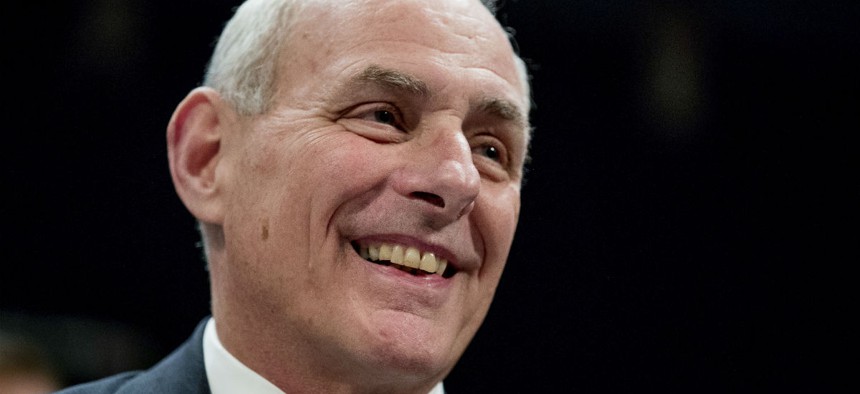How Trump Will 'Take the Shackles Off' DHS Employees With New Immigration Policies
DHS memos give officers more discretion on arrests, deportations.
The Homeland Security Department has issued new guidance to implement President Trump’s executive orders on immigration and border security, giving several components more authority to enforce laws and hire new personnel.
The memorandums by DHS Secretary John Kelly will “take the shackles off” Immigration and Customs Enforcement and Border Patrol employees, White House Press Secretary Sean Spicer said Tuesday. The sets of guidance are not meant to create mass deportations, he said, though they remove all classes and categories of undocumented immigrants exempt from deportation.
To meet the new priorities, Trump said in his orders last month ICE and CBP should grow their workforces by 15,000 employees and work with the Office of Personnel Management to receive special hiring authorities. DHS has not made any such request from OPM, a spokesman for the human resources agency said Tuesday.
ICE is “working on implementing a hiring plan” for its 10,000 new agents, the agency said. Kelly directed ICE and Customs and Border Protection to “immediately begin hiring,” subject to available resources. Border Patrol will hire 5,000 agents and 500 air and marine officers. Both agencies will also hire additional mission support and legal personnel to assist the new staff and help with policy implementation. Kelly directed DHS human capital leadership -- including the undersecretary for management, chief financial officer and chief human capital officer -- to implement the hiring surge.
Shawn Moran, vice president of the National Border Patrol Council, generally praised the implementation memos, but said there are still unanswered questions on the hiring provisions. He expressed concern about where the hiring and recruiting would take place, and whether there would be a “mad rush” to fill positions as seen when President George W. Bush attempted to quickly double the size of Border Patrol. He encouraged Border Patrol leadership to conduct the hiring in a “smart manner,” and said he did not expect the onboarding to happen overnight.
“We’re looking at a multi-year phase in,” Moran said. He emphasized the importance of properly training the new employees; in his memos, Kelly said the hiring must ensure “consistency in training and standards.” The DHS secretary also said it should take place “expeditiously.”
DHS employees will have more discretion in their enforcement duties, with Kelly giving officers the authority to assess for prioritized removal an undocumented immigrant who poses “a risk to public safety or national security.” The memos also leave it up to the “satisfaction of an immigration officer” to determine if an undocumented immigrant has been in the United States for less than two years; such individuals would be subject to expedited removals. DHS personnel can also arrest any individual whom an officer “has probable cause to believe is in violation of the immigration laws.”
“We are empowering DHS to carry out the laws on the books,” Spicer said. “The president wanted to take the shackles off the individuals in these agencies.”
In formalizing the end of DHS’ “catch and release” policy, Kelly said detention of immigrants who attempted to illegally enter the country is the most efficient way to enforce the nation’s laws. Keeping the immigrants in custody would ensure they show up for removal hearings and would not commit crimes. He conceded it would not be immediately possible to detain everyone and the department would therefore prioritize those posing the largest public safety threat.
Kelly instructed his department to direct all available resources toward creating new detention facilities near the U.S.-Mexico border, including temporary joint ICE-CBP structures. The Justice Department and U.S. Citizenship and Immigration Services will also identify best practices and efficiencies to improve court proceedings for immigrants and asylum seekers, Kelly said. ICE acquired 1,100 new beds since Trump issued his order in January and is currently defining contract requirements to purchase more. The agency is reviewing where those beds will go.
Former BP and ICE directors have warned Trump’s policies would further back up an already logjammed system (there are, for example, 534,000 cases pending in immigration courts). New hires will require computers, vehicles, guns and office space. In addition to new space and beds, the agencies will need a boost in transportation resources, such as buses, vans and airplane contracts. Support staff for new judges, agents and officers will likely include beefed up human resources and internal affairs.
A 2016 DHS inspector general’s report found the department’s components face “significant delays” in hiring despite a 2014 funding infusion to boost the workforces of ICE, the Border Patrol and the Secret Service. All of DHS has undergone cuts in human resources funding and money for new applicant-tracking software, the auditors said.
Asked about the funding for the hiring surge, detention space and other requirements from the memos, Spicer said DHS would both reallocate current resources and identify areas for savings. The White House will turn to Congress for its remaining budget shortfall.
The administration will also have to come up with funding for its proposed border wall. It has already identified three areas -- El Paso, Texas; Tucson, Ariz.; and El Centro, Calif. -- to begin construction, with BP currently assessing more suitable areas. The wall will be built “utilizing the most appropriate materials and technology,” Kelly said.
The burden for the new policies will not fall exclusively on DHS; Kelly also said the department will look to further deputize state and local law enforcement authorities to enforce immigration laws under the existing program known as 287(g).
Moran said BP agents were initially disappointed with the post-executive orders implementation, as there was a “bit of confusion” over how they would be carried out. The memos, however, have provided exactly what the union had hoped for -- perhaps not a coincidence as NBPC President Brandon Judd met with Trump’s transition team after the election to provide suggestions.
“It’s a laundry list of ways we thought border security could be improved,” Moran said.




